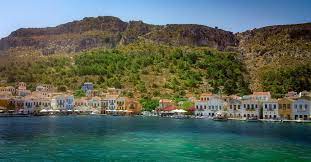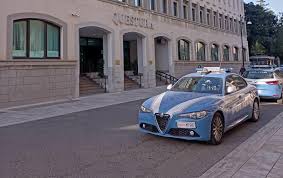Where to eat, stay, and play on Kastellorizo, Greece’s perfect tiny island

Athens: Greece has hundreds of islands, but few are as small or as perfectly formed as Kastellorizo. Ironically, the island was known in antiquity as Megisti (“The Greatest”), because it is the largest in an archipelago of tiny isles that lie where Europe ends and Asia begins. Just over a mile from the Lycian coast of Turkey—30 minutes by ferry or a 10-minute speedboat ride—this dinky Dodecanese isle packs in a heady cocktail of cultures. Ancient fortresses, wine presses, windmills, castles, mosques and marketplaces offer traces of the marauding powers who have been drawn to this desirable trading post through the ages.
These days, Kastellorizo attracts a cosmopolitan creative set looking for seclusion, serenity and the liberating simplicity afforded by an island where beauty is everywhere but very little to do. Only one tarmac road connects the tiny airstrip to the harbor town. There’s just one taxi, but everything is accessible on foot or by boat.

There is no nightlife to speak of, though dinner party invitations are highly prized among the artists and patrons who have handsomely restored summer houses on the island. Art collector Silvia Fiorucci has even created three artist residencies, including 4Rooms, with technicolour rooms designed by five different designers. The designer Michael Anastassiades is designing his own home in collaboration with Bijoy Jain, the cosmic architect behind Studio Mumbai. In late August, filmmakers from far and wide come for Beyond Borders, a documentary film festival with a cult following.
Kastellorizo is quietly becoming the Dodecanese answer to Hydra—a fashionable gathering place for cultural dialogue and experimentation, but with a more down-to-earth, out-of-the-way atmosphere. With fewer than 300 inhabitants, the low-key social scene centres around the skinny waterfront strip known as the Kordoni, or “shoelace.” The fishing boats moored outside the tavernas are as colorful as the neoclassical houses painted in contrasting shades of burgundy and baby blue, sunflower yellow and dove grey, pale pink and cypress green.
“The front row of Kastellorizo looks like a theatre set, and the backstreets are like the backstage where you find the real life of the local people with their secret stories,” says Marie Rivalant, a Parisian architect who has helped to reverse the fortunes of this thriving 19th-century shipping port, which was badly bombed and virtually abandoned after WWII. Fifteen years ago, Rivalant took a lease on a quayside pension named Mediterraneo after the Oscar-winning movie shot on the island in the early Nineties. The film was the catalyst for a slow trickle of tourism, which still comes in gentle waves rather than overwhelming surges.

“For many of our guests, the island became an addiction,” says Rivalant, who has since opened a Greek delicatessen and a second guesthouse, Casa Mediterraneo. “The main reason why well-known people enjoy this tiny island with their family and friends is that nobody disturbs them, and everyone respects their privacy. As the French say: “Pour vivre heureux, vivons cachés.”
The first boutique hotel on the island is still the most photogenic place to stay. The seaside terrace is reason enough to hop on a boat to Kastellorizo—as many have done, only to return summer after summer. Brightly colored cushions and rugs are strewn beneath the arches of the quayside veranda, the perfect launchpad for a swim before a Levantine breakfast at the communal table, where guests at this seven-room “maison de famille” mingle. The pièce de resistance is the ground floor suite, which has direct access to the sea. A melange of bold colors, richly patterned textiles and Ottoman antiques, the atmosphere here is intimate and unpretentious.
Poised on the rocky shoreline, this elegant three-bedroom mansion is surrounded by the sea. Owner Constantina Agapitou Crowley, affectionately known as Kastellorizo’s ambassador-at-large, is the daughter of the eponymous admiral who built the house. It’s still very much a family home, the blue-and-white interiors brimming with history and character. Even so, the main draw has to be the succession of waterfront terraces, with daybeds for sunbathing and step ladders that lure you into the deep blue sea. It’s a fifteen-minute stroll to the waterfront restaurants and cafés that line the harbor.
Housed in a trio of neoclassical mansions set back from the waterfront, Marie Rivalant’s second guesthouse has a slightly more muted, polished feel. All six suites have sea views and occupy an entire floor. Painted in dusky hues of ochre, burnt umber, olive green and terracotta, the interiors change throughout the day as sunlight streams through the huge windows. Guests gather under the pergola in the garden for a breakfast of fresh figs and goat’s cheese. At golden hour, an in-the-know crowd come for sundowners or pop-up suppers hosted by guest chefs. A collaboration between Rivalant and two other French designers enamored with the island (Grégoire Du Pasquier and Luc Jejeune), the whole place whispers romance. But it’s also an ideal base for getting to know who’s who on Kastellorizo.
You have to lie down flat to squeeze through the opening of this sea cave, but suddenly, you’re floating inside a dome of liquified blue light. Swimming through the cave is akin to an out-of-body experience, even when other excitable visitors are bobbing around you. Allegedly, the cave is home to a resident seal, as elusive as the Loch Ness monster. Access is only possible when the sea is calm.
Swimming: There are basically no beaches (sandy or otherwise) on Kastellorizo, and yet swimming, snorkelling and messing about in boats are some of the best things to do here. You can dive straight into the sea from the pier at Faros or Mandraki, another natural harbor just around the headland from the ferry dock—you might find yourself swimming with the turtles who lie in wait near the seafood tavernas. Or follow footpaths to remote swimming holes like Plakes, with flat limestone rock formations for sunbathing.
St George’s Island: Cruise over to the tiny islet of St George, whose rocky coastline is ideal for snorkeling. The island is uninhabited apart from a simple beach bistro run by a Greek-Turkish couple, Tsikos and Hurigul. The short menu blurs culinary boundaries, with gozleme (stuffed Turkish flatbread) served alongside Greek salad and club sandwiches.
Ro Island: There’s more excellent swimming and snorkelling around the equally tiny island of Ro (home to a small Greek military base, a lighthouse keeper and two castaway coves), but you’ll need to take your own provisions. You can rent your own boat, take a sea taxi or book an organised trip with the excellent local travel outfit, Visit Kastellorizo.
Monastery of Saint George of the Mountain: With its stunning mosaic floors and intricately carved iconostasis, this fortified monastic complex is totally worth the stiff hike up 400-odd steps carved into the rocky hillside above the harbour. The monastery is usually locked, but Yorgos, the island’s only taxi driver, has the key if you want to explore the secret crypt under the church. If you keep walking over the headland, you’ll reach Paleokastro, the ancient acropolis at the island’s highest peak, and the ultimate perch to watch the sun setting over Turkey.
Museum of Puzzles: Like many locals, Pantazis Houlis is Greek-Australian: he was born in Perth but grew up on Kastellorizo. A mathematician, Houlis is both a collector and inventor of puzzles; many of the 4000 puzzles he owns are on display at his highly interactive and entertaining Museum of Puzzles, where visitors can test their brainpower. Houlis also leads walking tours around the island.
Kastellorizo Historical Collection: This small museum is easy to spot: it’s housed in a mosque whose minaret punctuates the waterfront in the old Ottoman quarter. Household objects, folk art, costumes and archival documents tell the story of the island’s 19th- and 20th-century history—a long tussle for control by the Greeks, Ottomans, French, British, and Italians. Look out for the small, domed hammam nearby, beautifully renovated by restoration specialists Ifo architects.
With its gingham tablecloths and wooden chairs set beneath trees twinkling with fairy lights, the adorable taverna Ta Planatnia on Saint George’s Square looks like a film set. In fact, some scenes in Gabriele Salvatores’ Oscar-winning film Mediterraneo were shot here. The taverna also served as the crew’s canteen. Order the octopus stifado, slow-roast goat and stuffed onions (a local delicacy), all cooked with love by three local women.
Many regulars swear Alexandra’s is the best seafood restaurant on Kastellorizo. Once you’ve tried the gill-to-tail catch of the day, prepared multiple ways by chef-patron Michalis Papoutsis, you’re likely to agree.
A popular lunch spot for the smart yacht set, Lazarakis is the most well-known of the harborside fish restaurants. Go for baby Symi shrimps, grilled octopus, lobster linguine or whole grilled fish, paired with a list of crisp Greek wines. “Imperative: book a table on the jetty,” says Marie Rivalant. She should know: the owner, Georgios Lazarakis, is her husband.
Old Story, Old Time: Less fancy and more authentic than many of Kastellorizo’s waterfront restaurants, Old Story, Old Time is a friendly, family-run taverna that’s honestly priced. The fish soup, roast goat, and dolmades (stuffed vine leaves) are especially delicious. At the entrance of Kastellorizo harbor, near the mosque, the mellow beach bar Faro is perfect for horizontal afternoons, dipping in and out of the sea from the quayside daybeds. It’s a popular spot for sunset cocktails, too.
Boukla is a handsome boutique brimming with summery sarongs, kaftans, beach baskets, and costume jewelry made by Greek designers. Some of the linens, tableware, throws and robes that decorate Mediterraneo hotel are for sale at the on-site boutique. It’s a trove of textiles, clothes and objects picked up by Marie Rivalant on her travels in Morocco, India and Turkey. Behind the old market, Rivalant has also opened a deli selling Greek cheeses, charcuterie, honeys, preserves, and wines – perfect picnic fare for a hike or boat trip.
The cute port town of Kas on the Turkish coast is only a 30-minute ferry ride from Kastellorizo. Friday is the best day to visit Kas, as it’s market day—a cornucopia of farm produce, dried fruits, handicrafts and street food. But there are heaps of shops in the village lanes selling textiles, cushions, ceramics and spices. Just don’t forget to take your passport.





